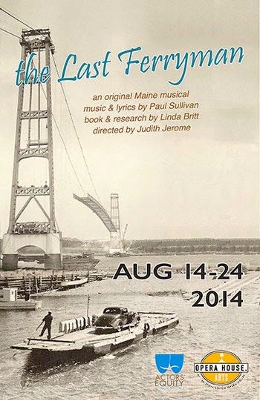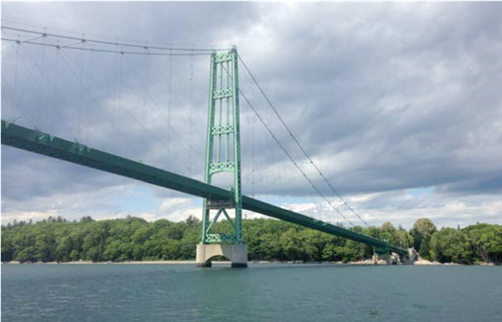Robert J. Dermody, AIA
Roger Williams University
rdermody@rwu.edu
Summary statement
In 1939, after a prolonged effort by local residents and business leaders, a tall, slender suspension bridge was built over Eggemoggin Reach connecting Deer Isle to the mainland. The 1000 ft. long bridge dramatically transformed the culture, economy, and landscape of the island.
Topic
Prior to the construction of the bridge, access to Deer Isle was via ferry from either Sedgwick or Rockland. In the early part of the 20th century, with the increasing availability of automobiles, island residents realized the need to improve ferry service to the island. The idea of a bridge was floated, but stalled early on due to cost. Support for construction of a bridge to the mainland gained momentum after several severe winters in the 1930’s froze Eggemoggin Reach, stopping ferry service, and preventing heating oil and supplies from getting to the island’s residents. Pressure for a reliable connection to the mainland came from residents who desired more freedom, and from local businesses who needed more flexibility. Other economic and social factors slowly moved the project forward. Island fisheries and quarries were particularly interested in a fixed connection to the mainland to improve deliveries. In the late 1930’s, with approval from the state, funds were secured from Washington. The Works Progress
Administration (WPA) and the Public Works Administration (PWA) ultimately funded construction of the bridge.
The narrow, long-span bridge was a dramatic piece of infrastructure on the remote Maine coast, appearing just as the great depression was ending. Site and severe budget constraints proved to be an engineering challenge for the designer, David B. Steinman, a prominent bridge builder from New York City. However, he brought local experience to the project, having completed an 800 ft. suspension bridge over the Penobscot River eight years earlier. The site across Eggemoggin reach, between Sedgwick and Little Deer Isle, was chosen for its short distance. However, this location was also challenging given the deep foundations required for the bridge’s towers. A minimum clearance requirement of 85 ft. resulted in a high arching bridge, with steep approaches on each side. The narrow two-lane bridge would turn out to be susceptible to wind induced oscillations, a critical concern in this coastal location. Steinman, an experienced bridge builder, was able to stabilize the bridge with structural modifications.
Scope
Since its opening, the bridge has had a profound effect on the life and landscape of the island. This paper will tell the story of the bridge from its inception to completion, and the subsequent influence the graceful structure has had on the isolated island. The impact of the new bridge was felt socially, culturally, economically. The bridge was completed just as the country was emerging from the depression and Americans were taking to the roads in unprecedented numbers, in their new automobiles. Population patterns shifted and fluctuated seasonally bringing more tourists and summer residents to the island. The fixed connection to the mainland provided local businesses and the historic fishing and quarrying industries with more reliable transportation
2017 Architecture, Culture, and Spirituality Symposium (ACS9) 1 of 2 options. The bridge allowed the island to grow and prosper. This paper will focus on the bridge structure as well as its social, cultural, economic significance.
In the 2014, the State of Maine, and residents of Deer Isle enthusiastically observed the 75th anniversary of their beloved bridge. The occasion was marked with many celebrations, including a specially commissioned musical, “The Last Ferryman” produced by Opera House Arts at the Stonington Opera House. The community’s eager participation in these symbolic events is a testament to the important, daily influence the bridge continues to have on the life of the island.


Image: Peter Behrens Image: by author
Conclusions
The Deer Isle Bridge has had a profound and lasting impact on the life of the island’s residents and on the development of the Island. This paper will focus on the bridge structure as well as its social, cultural, economic significance.
References
Gratwick, Harry. “The Year Steel and Cable Changed Deer Isle.” Island Journal, 2014.
Gross, Clayton H. Steel over Eggemoggin: A History of the Deer Isle-Sedgwick Bridge. Penobscot Books, 1989
Sullivan, Paul. The Last Ferryman. Stonington, Maine: Opera House Arts, 2014.



